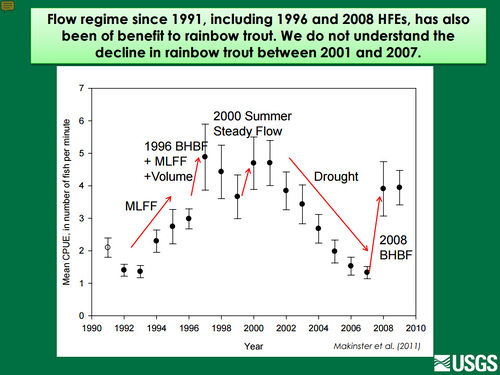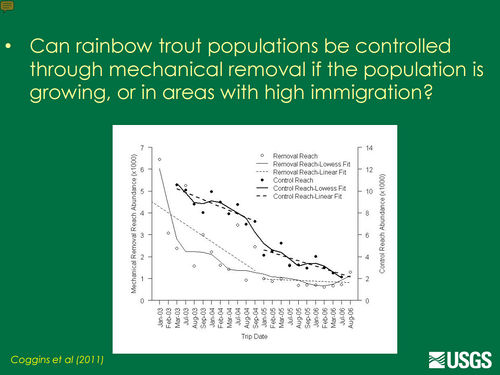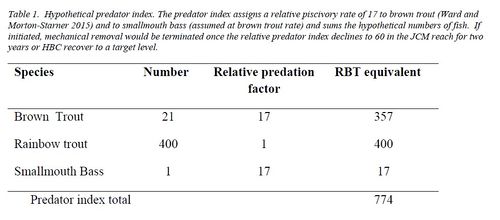|
|
| Line 117: |
Line 117: |
| | *[https://www.usbr.gov/uc/rm/amp/amwg/mtgs/11aug24/Attach_11a.pdf USGS Fact Sheet: An Experiment to Control Nonnative Fish in the Colorado River, Grand Canyon, Arizona] | | *[https://www.usbr.gov/uc/rm/amp/amwg/mtgs/11aug24/Attach_11a.pdf USGS Fact Sheet: An Experiment to Control Nonnative Fish in the Colorado River, Grand Canyon, Arizona] |
| | *[https://www.usbr.gov/uc/rm/amp/amwg/mtgs/11aug24/Attach_16.pdf AIF: Report on Two Environmental Assessments (EAs): Protocol for High-Flow Experimental Releases EA and Non-native Fish Control EA and PPTs] | | *[https://www.usbr.gov/uc/rm/amp/amwg/mtgs/11aug24/Attach_16.pdf AIF: Report on Two Environmental Assessments (EAs): Protocol for High-Flow Experimental Releases EA and Non-native Fish Control EA and PPTs] |
| | + | |
| | + | '''2013''' |
| | + | *[https://www.usbr.gov/uc/rm/amp/twg/mtgs/03jun30/Attach_07b.pdf Non-native Fish Removal Efforts in Grand Canyon: A Proposed Modification to Ongoing Activities] |
| | | | |
| | |- | | |- |
|
Our results suggest that removal efforts were successful in rapidly shifting the fish community
from one dominated numerically by nonnative species to one dominated by native species. Additionally, increases
in juvenile native fish abundance within the removal reach suggest that removal efforts may have promoted greater
survival and recruitment. However, drought-induced increases in river water temperature and a systemwide decrease
in rainbow trout abundance concurrent with our experiment made it difficult to determine the cause of the apparent
increase in juvenile native fish survival and recruitment.
|
Links and Information
|
|
|
Projects
|
|
|
|
|
|
|
Presentations and Papers
|
|
2017
2013
2012
2011
2013
|
|
|
Tier 1 Trigger – Early Intervention Through Conservation Actions:
- 1a. If the combined point estimate for adult HBC (adults defined ≥200 mm) in the Colorado River mainstem LCR aggregation; RM 57-65.9) and Little Colorado River (LCR) falls below 9,000 as estimated by the currently accepted HBC population model (e.g., ASMR, multi-state).
-OR-
- 1b. If recruitment of sub-adult HBC (150-199mm) does not equal or exceed estimated adult mortality such that:
- Sub-adult abundance falls below a three-year running average of 1,250 fish in the spring LCR population estimates, or
- Sub-adult abundance falls below a three-year running average of 810 fish in the mainstem Juvenile Chub Monitoring reach (JCM annual fall population estimate; RM 63.45-65.2).
Tier 1 Trigger Response:
- Tier 1 conservation actions listed below will be immediately implemented either in the LCR or in the adjacent mainstem. Conservation actions will focus on increasing growth, survival and distribution of HBC in the LCR & LCR mainstem aggregation area.
Tier 2 Trigger - Reduce threat using mechanical removal if conservation actions in Tier 1 are insufficient to arrest a population decline:
Mechanical removal of nonnative aquatic predator will ensue:
- If the point abundance estimate of adult HBC decline to <7,000, as estimated by the currently accepted HBC population model.
Mechanical removal will terminate if:
- Predator index (described below) is depleted to less than 60 RBT/km for at least two years in the JCM reach and immigration rate is low (the long term feasibility of using immigration rates as a metric still needs to be assessed),
-OR-
- Adult HBC population estimates exceed 7,500 and recruitment of sub-adult chub exceed adult mortality for at least two years.
If immigration rate of predators into JCM reach is high, mechanical removal may need to continue. These triggers are intended to be adaptive based on ongoing and future research (e.g., Lees Ferry recruitment and emigration dynamics, effects of trout suppression flows, effects of Paria River turbidity inputs on predator survival and immigration rates, interactions between humpback chub and rainbow trout, other predation studies).
|
Other Stuff
|
|
|
|



